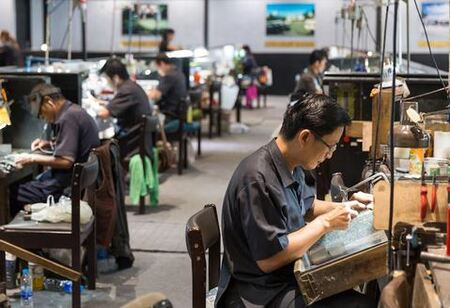
China's June Manufacturing Activity Shrinks for Third Month


China's manufacturing sector contracted for the third consecutive month in June, a survey released indicated, pointing to challenges faced by factory managers in attracting domestic customers as international sales falter amidst a delicate trade agreement with the US.
The official purchasing managers' index (PMI) increased to 49.7 in June from 49.5 in May, remaining below the critical 50 threshold that indicates growth versus contraction, aligning with a median estimate of 49.7.
The sub-index for new orders rose to 50.2 in June compared to 49.8 in May, while the new export orders sub-index also improved to 47.7, up from 47.5.
The non-manufacturing PMI, which encompasses services and construction, increased to 50.5 from 50.3.
Due to ongoing weak domestic demand, aggravated by a drawn-out property crisis that is tightening household spending and increasing deflationary pressures, factory owners have few strong options other than to hold onto their stock and wait for Beijing to potentially secure agreements that could alleviate trade conflicts with the United States and the European Union, analysts note.
However, authorities cannot let China's extensive manufacturing sector stagnate or contract if they are to achieve their ambitious goal of "around 5 percent" growth by 2025.
In May, the profits of China's industrial companies dropped sharply back into decline, falling 9.1 percent year-on-year, according to separate data from the National Bureau of Statistics released on Friday, which officials attributed to weak demand and decreasing prices of industrial products.
Also Read: The Coast is Clear for Nuclear Energy's Bounce Back into the Market
Policymakers are optimistic that they can continue with the reforms initiated late last year to shift the world's second-largest economy from being manufacturing-driven to consumer-driven, Premier Li Qiang informed participants at the World Economic Forum and Asian Infrastructure Investment Bank meetings last week.
Li stated that this transition in growth drivers, which economists consider essential for China's future, could be advanced while still achieving robust growth.
Nevertheless, economists caution that the transition may require several years, and that reforms often lead to a temporarily muted economy in the near term.
While the US and China have agreed on a framework for a trade deal, analysts predict that US tariffs will remain significantly above historical levels, continuing to pressure exporters and prompting officials to seek alternative markets or stimulate domestic demand.
Also Read: A Solution to Asia's Drastic Food Wastage? There Might be One
Analysts expect the private sector Caixin PMI to rise to 49.0, an improvement from 48.3 the previous month. The private sector data is set to be published last week.

